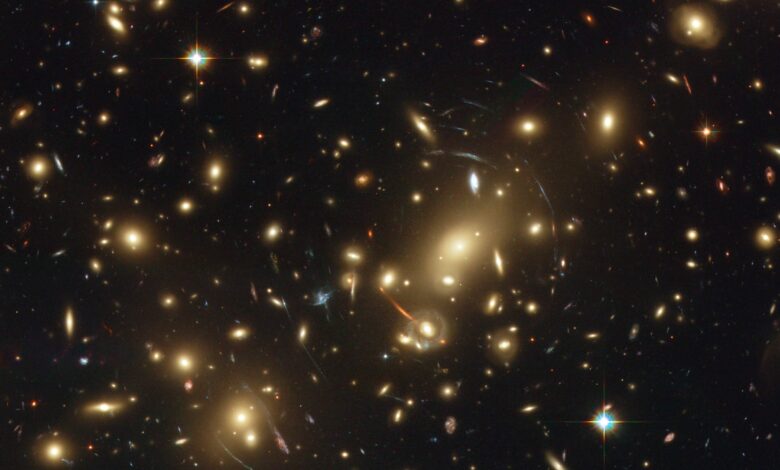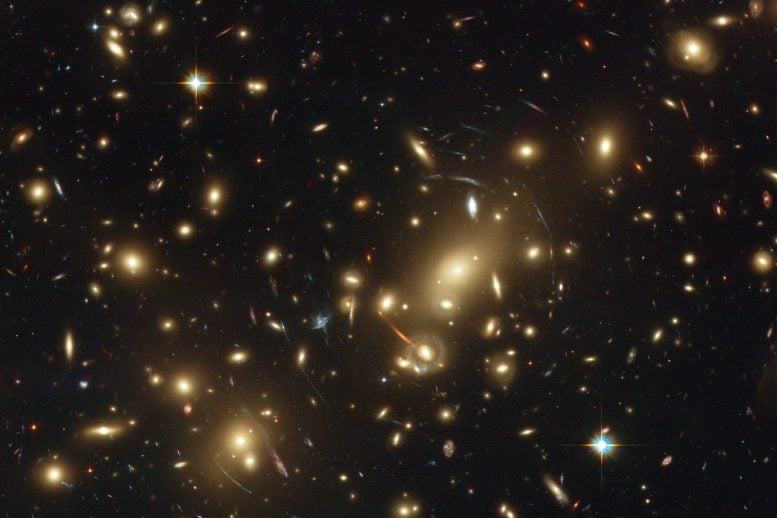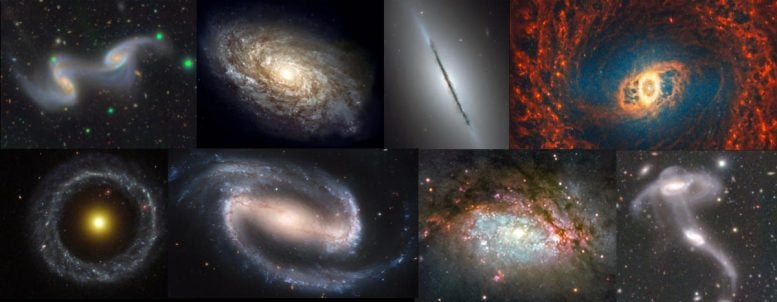Machine Learning Uncovers New Insights, Challenging Galaxy Formation Theories


Credit: NASA, ESA, and Johan Richard; Acknowledgment: Davide de Martin & James Long (ESA/Hubble)
Recent research has revealed that galaxies in denser environments tend to be significantly larger than isolated ones, challenging existing theories of galaxy formation.
This discovery was made possible by machine learning and extensive data from millions of galaxies. The findings raise new questions about the role of dark matter and galaxy mergers in shaping the cosmos.
Galaxies in Dense vs. Isolated Environments
For decades, scientists have known that some galaxies reside in dense environments with lots of other galaxies nearby. Others drift through the cosmos essentially alone, with few or no other galaxies in their corner of the universe.
A new study has found a major difference between galaxies in these divergent settings: Galaxies with more neighbors tend to be larger than their counterparts, which have a similar shape and mass, but reside in less dense environments. In a paper published on August 14 in the Astrophysical Journal, researchers at the University of Washington, Yale University, the Leibniz Institute for Astrophysics Potsdam in Germany, and Waseda University in Japan report that galaxies found in denser regions of the universe are as much as 25% larger than isolated galaxies.

Machine Learning Reveals Galactic Trends
The research, which used a new machine-learning tool to analyze millions of galaxies, helps resolve a long-standing debate among astrophysicists over the relationship between a galaxy’s size and its environment. The findings also raise new questions about how galaxies form and evolve over billions of years.
“Current theories of galaxy formation and evolution cannot adequately explain the finding that clustered galaxies are larger than their identical counterparts in less dense regions of the universe,” said lead author Aritra Ghosh, a UW postdoctoral researcher in astronomy and an LSST-DA Catalyst Fellow with the UW’s DiRAC Institute. “That’s one of the most interesting things about astrophysics. Sometimes what the theories predict we should find and what a survey actually finds are not in agreement, and so we go back and try to modify existing theories to better explain the observations.”
Contradictory Past Studies on Galaxy Size
Past studies that looked into the relationship between galaxy size and environment came up with contradictory results. Some determined that galaxies in clusters were smaller than isolated galaxies. Others came to the opposite conclusion. The studies were generally much smaller in scope, based on observations of hundreds or thousands of galaxies.
In this new study, Ghosh and his colleagues utilized a survey of millions of galaxies conducted using the Subaru Telescope in Hawaii. This endeavor, known as the Hyper Suprime-Cam Subaru Strategic Program, took high-quality images of each galaxy. The team selected approximately 3 million galaxies with the highest-quality data and used a machine learning algorithm to determine the size of each one. Next, the researchers essentially placed a circle — one with a radius of 30 million light years — around each galaxy. The circle represents the galaxy’s immediate vicinity. They then asked a simple question: How many neighboring galaxies lie within that circle?
The answer showed a clear general trend: Galaxies with more neighbors were also on average larger.
The Role of Dark Matter and Mergers
There could be many reasons why. Perhaps densely clustered galaxies are simply larger when they first form, or are more likely to undergo efficient mergers with close neighbors. Perhaps dark matter — that mysterious substance that makes up most of the matter in the universe, yet cannot be detected directly by any current means – plays a role. After all, galaxies form within individual “halos” of dark matter and the gravitational pull from those halos plays a critical role in how galaxies evolve.
“Theoretical astrophysicists will have to perform more comprehensive studies using simulations to conclusively establish why galaxies with more neighbors tend to be larger,” said Ghosh. “For now, the best we can say is that we’re confident that this relationship between galaxy environment and galaxy size exists.”
Advancements in Machine Learning for Astronomy
Utilizing an incredibly large dataset like the Hyper Suprime-Cam Subaru Strategic Program helped the team reach a clear conclusion. But that’s only part of the story. The novel machine learning tool they used to help determine the size of each individual galaxy also accounted for inherent uncertainties in the measurements of galaxy size.
“One important lesson we had learned prior to this study is that settling this question doesn’t just require surveying large numbers of galaxies,” said Ghosh. “You also need careful statistical analysis. A part of that comes from machine learning tools that can accurately quantify the degree of uncertainty in our measurements of galaxy properties.”
GaMPEN: A Tool for the Future
The machine learning tool that they used is called GaMPEN — or Galaxy Morphology Posterior Estimation Network. As a doctoral student at Yale, Ghosh led development of GaMPEN, which was unveiled in papers published in 2022 and 2023 in the Astrophysical Journal. The tool is freely available online and could be adapted to analyze other large surveys, said Ghosh.
Though this new study focuses on galaxies, it also forecasts the types of research — centered on complex analyses of incredibly large datasets — that will soon take astronomy by storm. When a generation of new telescopes with powerful cameras, including the Vera C. Rubin Observatory in Chile, come online, they will collect massive amounts of data on the cosmos every night. In anticipation, scientists have been developing new tools like GaMPEN that can utilize these large datasets to answer pressing questions in astrophysics.
“Very soon, large datasets will be the norm in astronomy,” said Ghosh. “This study is a perfect demonstration of what you can do with them — when you have the right tools.”
Reference: “Denser Environments Cultivate Larger Galaxies: A Comprehensive Study beyond the Local Universe with 3 Million Hyper Suprime-Cam Galaxies” by Aritra Ghosh, C. Megan Urry, Meredith C. Powell, Rhythm Shimakawa, Frank C. van den Bosch, Daisuke Nagai, Kaustav Mitra and Andrew J. Connolly, 14 August 2024, The Astrophysical Journal.
DOI: 10.3847/1538-4357/ad596f
Co-authors on the study are Meg Urry, professor of physics and of astronomy at Yale; Meredith Powell, a research fellow with the Leibniz Institute; Rhythm Shimakawa, associate professor at Waseda University; Frank van den Bosch, a Yale professor of astronomy; Daisuke Nagai, professor of physics and of astronomy at Yale; Kaustav Mitra, a doctoral student at Yale; and Andrew Connolly, professor of astronomy at the UW and faculty member in the DiRAC Institute and the eScience Institute. The research was funded by NASA, the Yale Graduate School of Arts & Sciences, the John Templeton Foundation, the Charles and Lisa Simonyi Fund for Arts and Sciences, the Washington Research Foundation and the UW eScience Institute.
Source link



